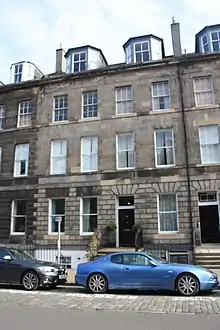


Prof Lewis Dunbar Brodie Gordon FRSE (1815–1876) was a Scottish civil engineer.
Life
He was the fourth son of Anne Clunes (d.1881) and her husband, Joseph Gordon WS,[1] an Edinburgh lawyer. They lived at 27 London Street in Edinburgh's New Town.[2] He was educated at the High School in Edinburgh then went to the University of Edinburgh. A student and assistant to Marc Brunel, during the construction of the Thames Tunnel, he made a career change to mining. Registering as a student at the Freiburg School of Mines, Germany, he then studied further at the École Polytechnique in Paris.
In 1838 he visited the mines at Clausthal, and met Wilhelm Albert. Impressed by what he saw, he wrote to his friend Robert Stirling Newall, urging him to "Invent a machine for making (wire ropes)". On receipt of Gordon's letter, Newall designed a wire rope machine. On Gordon's return to the UK in 1839, he formed a partnership with Newall and Charles Liddell, registering R.S. Newall and Company in Dundee. On 17 August 1840, Newall took out a patent for "certain improvements in wire rope and the machinery for making such rope," and R.S. Newall and Company commenced making wire ropes for "Mining, Railway, Ships' Rigging, and other purposes".[3]
He was Professor of Civil Engineering at the University of Glasgow from 1840 to 1855. In 1845 he was elected a Fellow of the Royal Society of Edinburgh his proposer being James David Forbes.[1]
Gordon became a mentor to the brothers James Thomson and William Thomson, encouraging their interest in the development of a general theory of heat. In 1848 he gave the brothers a copy of French physicist Sadi Carnot's 1824 treatise On the Motive Power of Fire, with which he used to write his first thermodynamics article the 1848 "On an Absolute Thermometric Scale Founded on Carnot’s Theory of the Motive Power of Heat", which founded the absolute temperature scale. He was conferred with Honorary Membership of the Institution of Engineers and Shipbuilders in Scotland in 1859.
He died on 28 April 1876 at Poynter's Grove[1] in Totteridge in Hertfordshire and is buried in the family plot in Greyfriars Kirkyard in central Edinburgh. The grave lies on the western wall of the western extension.
Family
His sister married William Siemens, Carl Wilhelm Siemens, of Siemens & Halske. Gordon's wife was from Hanover and linked by marriage to the Siemens family.[4]
References
- 1 2 3 Biographical Index of Former Fellows of the Royal Society of Edinburgh 1783–2002 (PDF). The Royal Society of Edinburgh. July 2006. ISBN 0-902-198-84-X.
- ↑ Edinburgh and Leith Post Office Directory 1815-16
- ↑ Bill Burns. "Wire Rope and the Submarine Cable Industry". atlantic-cable.com. Retrieved 23 September 2011.
- ↑ J D Scott, Siemens Brothers 1858-1958, Weidenfeld & Nicolson, London, 1958